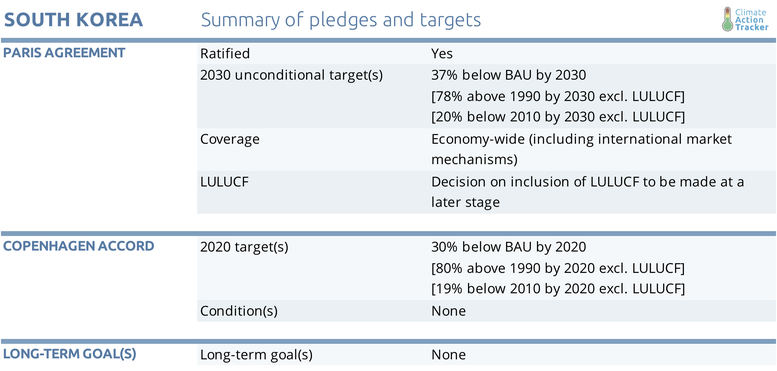Pledges And Targets
Summary table

Paris Agreement targets
South Korea signed the Paris Agreement on 22 April 2016 and ratified it on 3 November 2016. Its NDC proposes an economy-wide target to reduce GHG emissions by 37% below business-as-usual (BAU) emissions of 842 MtCO2e/year in 2030 (Republic of Korea, 2015). In absolute terms, this is a target of 530 MtCO2e/year excluding land-use, land-use change and forestry (LULUCF) (equivalent to 78% above 1990 emission levels).
Based on the recently adopted revised 2030 GHG roadmap, South Korea intends to achieve a 32.5% emissions reduction below BAU domestically. This is an improvement on the 27.5% previously announced. The remaining 4.5% can be achieved through international market mechanisms (ICAP, 2018; Ministry of Environment, 2018).
South Korea’s NDC is an economy-wide target covering all greenhouse gases. It states that a decision on the inclusion of the LULUCF sector, and the accounting rules to use for it, will be made “a later stage” (Republic of Korea, 2015). Our current analysis treats South Korea’s NDC target as excluding LULUCF. South Korea’s LULUCF sector has been a sink of between 34 and 59 MtCO2e/year over 1990–2014 (UNFCCC, 2019).
2020 pledge
Under the Copenhagen Accord, South Korea agreed to reduce its emissions by 30% below business-as-usual (BAU) emissions by 2020. It proposed this unconditional target in November 2009 and submitted it to the Copenhagen Accord on 25 January 2010.
Under the BAU projections from the Third National Communication, this pledge would have resulted in emissions of 546 MtCO2e/year in 2020 excluding LULUCF (equivalent to 78% above 1990 emission levels).
However, South Korea has replaced the 2020 pledge by the weaker 2030 NDC target in its updated Green Growth Act (National Law Information Center, 2016). Although the Copenhagen pledge has not officially been withdrawn, it is no longer actively pursued. We therefore no longer take this target into account when calculating the global temperature increase resulting from the current pledges of all countries.
Further analysis
Latest publications
Stay informed
Subscribe to our newsletter




